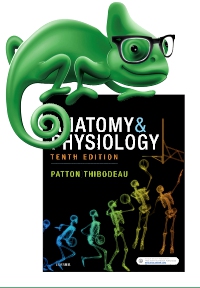
Elsevier Adaptive Quizzing for Anatomy and Physiology, 10th Edition
Elsevier Adaptive Quizzing - Next Generation

Corresponding chapter-by-chapter to Anatomy and Physiology, 10th Edition, Elsevier Adaptive Quizzing (EAQ) integrates seamlessly into your course to help students of all skill levels focus their study time and effectively prepare for class, course exams, and summative exams. EAQ is comprised of a bank of high-quality practice questions that allows students to advance at their own pace — based on their performance — through multiple mastery levels for each chapter. A comprehensive dashboard allows students to view their progress and stay motivated. The educator dashboard and reporting capabilities enable you to monitor the activity of individual students, assess overall class performance, and identify areas of strength and weakness, ultimately helping to achieve improved learning outcomes.
Newer Edition Available
Elsevier Adaptive Quizzing for Anatomy and Physiology
-
- UNIQUE! Elsevier’s trusted, market-leading content serves as the foundation for all questions, which are written, reviewed, and leveled by experienced educators, item writers, and authors. Each question is accompanied by a specific chapter and page within your Elsevier text for convenient reference.
- UNIQUE! Essential test-taking tips and strategies help students learn how to successfully dissect and tackle different question types and improve test-taking skills for both course exams and summative exams.
- Confidence level indicators allow students to indicate their confidence when submitting answers, providing valuable insight into areas where they might be overconfident and require further study.
- UNIQUE! Students can practice in Study Mode, which provides immediate feedback, or in Exam Mode where the quiz is timed and results are summarized at the end.
- UNIQUE! In addition to detailed rationales for each question, select questions include interactive, multimedia resources such as illustrations, animations, videos, audio clips, summary tables, and study tips to engage students with different learning styles and reinforce challenging material.
- Engaging, easy-to-use interface ensures that students and educators can navigate through the program with ease.
- Multiple mastery levels for each chapter allow students to progress from one level to the next based on individual performance.
- Alternate item format questions — including multiple-response, fill-in-the-blank, prioritizing, graphic options, chart/exhibit, video, audio, and hot spot — provide valuable summative exam preparation.
- The comprehensive student dashboard allows each individual to view their personal learning progress with summaries of their strengths, weaknesses, mastery levels, and normative data.
- A robust educator dashboard highlights usage and performance summaries; areas of strength and weakness tied to chapters for each student and class; and normative data that educators can use to modify lectures or class activities accordingly.
-
UNIT ONE: The Body as a Whole 1. Organization of the Body 2. Homeostasis 3. Chemistry of Life 4. Biomolecules 5. Cell Structure 6. Cell Function 7. Cell Growth and Development 8. Introduction to Tissues 9. Tissue Types UNIT TWO: Support and Movement 10. Skin 11. Skeletal Tissues 12. Axial Skeleton 13. Appendicular Skeleton 14. Articulations 15. Axial Muscles 16. Appendicular Muscles 17. Muscle Contraction UNIT THREE: Communication, Control, and Integration 18. Nervous System Cells 19. Nerve Signaling 20. Central Nervous System 21. Peripheral Nervous System 22. Autonomic Nervous System 23. Physiology of Sensation 24. Special Senses 25. Endocrine Regulation 26. Endocrine Glands UNIT FOUR: Transportation and Defense 27. Blood 28. Heart 29. Blood Vessels 30. Circulation of Blood 31. Lymphatic System 32. Innate Immunity 33. Adaptive Immunity 34. Stress UNIT FIVE: Respiration, Nutrition and Excretion 35. Respiratory Tract 36. Ventilation 37. Gas Exchange and Transport 38. Upper Digestive Tract 39. Lower Digestive Tract 40. Digestion and Absorption 41. Nutrition and Metabolism 42. Urinary System 43. Fluid and Electrolyte Balance 44. Acid-Base Balance UNIT SIX: Reproduction and Development 45. Male Reproductive System 46. Female Reproductive System 47. Growth and Development 48. Genetics and Heredity Photo/Illustration Credits Index
-
This product is available in the following formats:















